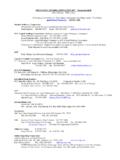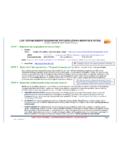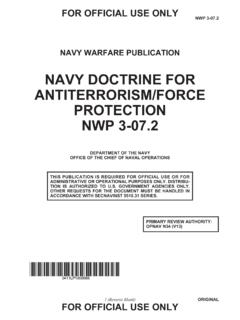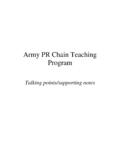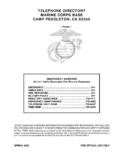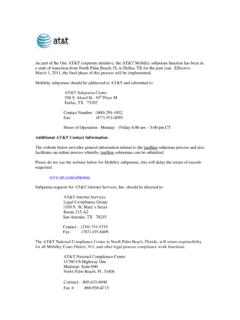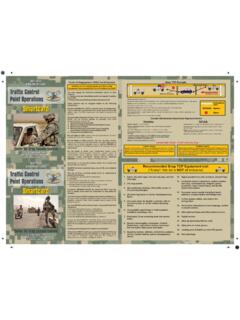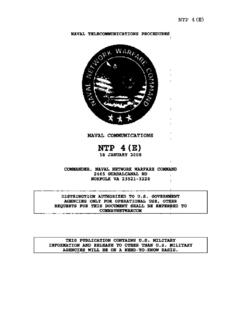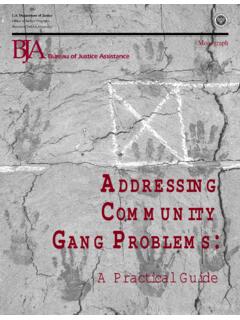Transcription of ontents - Public Intelligence
1 Confidentiality Statement ..page iiCredits ..page iiiintroduction ..page ivAcknowledgments ..page 127rEFERENCES ..page 128 THE GANGSB loods ..page 1 Almighty Latin King Nation ..page 40 Netas ..page 74 Crips ..page 86 Mara Salvatrucha (MS-13) ..page 109 Mexican Gangs ..page 116 ContentsLaw EnforcementSensitive InformationThe material contained within this document isCONFIDENTIAL AND LAW ENFORCEMENT is subject to amendment or modification at anytime and is notintended for distribution to non-law enforcement is a compilation of various gang Intelligence sources, and is aproduct of the NEW YORK / NEW JERSEY HIDTAREGIONAL Intelligence CENTER, THE NEW YORKCITY POLICE DEPARTMENT S Intelligence DIVISIONAND DETECTIVE BUREAU GANG questionsregarding this material may be resolved by calling:888-NY-HIDTAW arningThis document has been released to your agency for use bypersons having a need-to-know.
2 This document may be reproduced,but limited to only that required for operational needs. Unlessauthorized by the originating agency, this document may not bereleased beyond your agency. This document should be afforded theappropriate level of YORK CITY POLICE DEPARTMENT Police Commissioner Bernard B. KerikFirst Deputy Commissioner Joseph P. DunneChief of Department Joseph J. EspositoChief of Detectives William H. AlleeDETECTIVE BUREAU GANG DIVISIOND eputy Inspector William P. TartagliaCaptain Charles M. AlifanoLieutenant Joseph J. FalcoINTELLIGENCE DIVISIONI nspector Edmund P. HarnettDeputy Inspector Patrick J. BradleyLieutenant Kenneth W. RoselloNEW YORK / NEW JERSEY HIDTAREGIONAL Intelligence CENTERC hauncey Parker, DirectorPROJECT COORDINATORSP olice Officer Vicki A.
3 McDermottPolice Officer Richard E. FasanoGangs are a prevalent source of potential criminality in the New York City areatoday. The New York City Police Department s purpose in producing this gangbook is primarily to assist our patrol officers and other law enforcement officials inthe identification of gang members and their potential for criminality. It is importantfor officers to be able to recognize gang member characteristics, as the gangpopulation has committed numerous violent crimes against each other and innocentvictims in recent years. Officers knowledgeable in areas of gang identification can notonly prevent and combat crime, but will also be able to protect themselves as well asother officers and book is a compilation of various gang Intelligence information from varioussources including detective and police officer files, primarily confiscated from arrestedand/or incarcerated individual gang notes and drawings.
4 Additional material wasobtained from other law enforcement agencies publications and presentations usedfor internal officer training, as well as from various other gang publications andinternet major New York City gangs are presented in this book: the Bloods, theAlmighty Latin King and Queen Nation, the Netas, the Crips, Mara Salvatrucha(MS-13), and the Mexican Gangs. Sections within this book include the origin andhistory of the gang, its structure, rules and regulations, oaths and pledges, symbols andemblems, coded language and hand signals, clothing, tattoos and graffiti . It is our hopethat an officer s knowledge of gang characteristics will assist in combating gang-motivated crimes and reduce the propensity for violence towards the lawenforcement community and innocent to popular belief, the Bloodsgang have been circulating throughoutthe country for the past twenty-five gang was actually created in the early1970's in Los Angeles to compete with a rivalgang called the "Avenue Boys", which wasactive in the Los Angeles area for severalyears.
5 Eventually, the name was changed tothe "Avenue Cribs". By early 1972, the name"Crib" was gradually phased out andsubstituted with "Crip".Subsequently, the formation of the Cripsgang is historically important to thecreation of the Bloods. Ironically, the Bloodswere an offshoot from their now rival gang,the Crips. By 1971, many Crips gangs hadmerged with other Crips sets and hadexpanded their gang culture and ideologythroughout the Los Angeles area. Many gangsbegan to populate the Los Angeles area; sev-eral of these gangs eventually becoming partof the original Bloods family. The Piru StreetBoys in Compton, the Bishops, Athens ParkBoys and the Denver Lanes were originallyassociated with the Crips prior to , they were temporarily knownas the Piru Street Crips and also wore thetraditional blue bandannas as part of 1972, the Crips from Compton, and thePirus had a conflict, which resulted in arumble.
6 The Pirus were out-numbered, andthe Crips won the battle. The Pirus wantedto terminate peaceful relations with the Cripsand had turned to another gang for back gangs then called a meeting on PiruStreet. The Crips had murdered a Brimmember earlier that year, so the Pirus askedthe Brims to attend the meeting along withthe Denver Lanes and the the gang meeting, the gangs discussedhow to combat Crips intimidation, aswell as the creation of a new alliance tocounter the Crips. Hence, the group createda united organization, which eventually became known as the Bloods. The Pirus,Brims, Athens Park Boys and other groupswho had been threatened or attacked by theCrips, joined the Bloods, thus the formationof the United Blood July 1993, the Bloods surfaced in sectionC-73 at the NYC Department ofCorrection facility on Riker's Island.
7 TheBloods godfather was able to unite African-American prisoners to compete with theHispanic gangs, such as Latin Kings and theNetas, who were more organized and betterequipped to dominate the godfather, Mack, is believed tohave spent time on the West Coast,where he became a member of the WestCoast Miller Gangsta Bloods. The ideology heimported caught on quickly, spread to thestreets, and eventually developed into theformation of the various Bloods subsets, suchas Nine Trey Gangstas;183 Gangstas; Sex,Money, Murder, etc. (see page 4 for detailedinformation on the Bloods subsets). Whilethe East Coast Bloods are based on the ide-ology of the West Coast Bloods, the leadersdo not appear to have any contact with eachother.
8 The West Coast Bloods considerthemselves superior to East Coast Bloods,due in large part, to newspaper coverage ofthe East Coast Bloods victimizing "Neutrals"(those individuals not involved in gangwarfare).OriginHistory in NYC2stabbings or slashings).Young Blood:New , the Bloods are attemptingto reorganize their organizationalstructure, creating yet another hierarchy:Godfather:The highest rankingmember of the nation, held by one member,known as OG Mack. Original Gangsta:Achieved aftercompleting the first two levels of indoctrina-tion and successfully passing a test on therules and history conducted by a Top Bloods view themselves asgangsters and have adopted akas offamous organized crime members such as AlCapone, Frank Nitti and Babyface Bloods believe in fighting for thegang s principles at all times.
9 No Bloodgang member is better than the next. EachBlood is a soldier, putting in work (fighting),maintaining the superiority of all Bloods overtheir enemies. Their organizational structureis conducive to the gang s ideology, althoughtheir command structure is constantlychanging and has several different following numbers are gang codes usedto represent each specific First Superior:He is theleader, the disciplinary officer. His function isto oversee the Second Superior:Provides strategies and information to the1st superior and carries out his duties in Minister ofInformation:Provides weapons anddiscipline to all members of the Commanding Officer(Captain):Dictates orders to Head Lieutenant:Assistsand advises the Captain, carrying out theCaptain s duties in his Lieutenant:Ensures that theprincipal soldiers carry out orders as issuedby the Principal Soldier:Complies with orders from the Lieutenants,keeps fighting the enemy ( banging ) at Gangstas - :Highest rank of the nation.
10 Responsible forthe making of the rules and appointingsuperiors. Rank can be held by more than oneperson, usually the originating set :The leader of one of Blood:Witnessed by asuperior committing a violent crime ( Gang Structure3 The following material wasconfiscated by the New York CityDepartment of Corrections from anactual incarcerated Bloods questions are apparently asked by theFirst Superior to a prospective gang you would like to be a Blood? you know that being a Blood is trulyspecial and respected? you know that the Bloods are a well-known organization all over the world? you willing to obey and carry out rulesand regulations? you willing to respect your CommandingOfficer? you willing to respect your fellow Bloods?)

